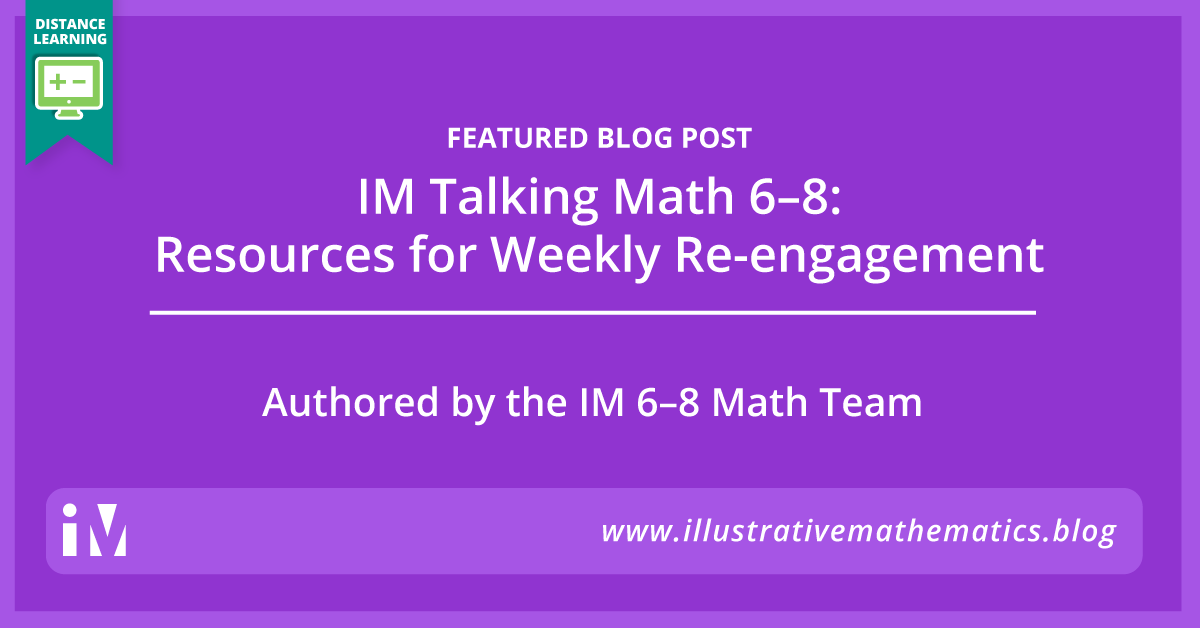By IM 6–8 Math Team
This week, IM is launching a new resource to support students and teachers with distance learning. Each week we will publish an open-ended prompt or image that invites math conversation, and a series of 3–5 questions. The questions are designed so that all 6–8 students have an entry point for the first question, and all students will find something both familiar and challenging in each set.

These prompts are designed to support re-engagement and deepening understanding of content typically already covered by this time of year, though there are opportunities for self-directed exploration of related content in other grade levels. Here are some ways you might use the prompts.
For Students and Caregivers:
A PDF version of this note to share with families is here.
Here are some images and questions to start conversations. They might help you remember some of the math you’ve studied this year, and give you a chance to keep your “math talk” muscles in shape.
Suggested norms for talking math:
- Give quiet think time before sharing ideas.
- If someone is stuck, ask questions, don’t tell.
- Try to think of different ways, not just one way.
- We learn from our mistakes.
- If everyone is stuck, notice and wonder together, take a break, or try to think of a similar problem you could do (this would be easier if…).
- Brainstorm and write down your ideas together.
Routine:
- Warm-up: Talk about the warm-up question together. People of all ages can share their ideas!
- Everyone try the first problem: Give everyone 2–4 minutes of quiet think time and then start talking about your ideas.

- Keep going with any other problems that feel familiar and doable.
- Are you ready for more?
- Reflect on what you did and how it went.
- Connect with a classmate and ask them about their ideas.
For Teachers and Students:
You might choose to share these prompts with students to work on with the people around them. You might also incorporate them into virtual meetings. And doing both is great—if students work with others, then students can share everyone’s ideas with others in the class during online meetings.
No synchronous or online meeting time
Teachers can invite students to discuss just the initial launch with the people they are sheltering with, or to work on the packet of problems. Students and caregivers can also find the problems online themselves, choosing problems they feel more familiar with at first.
Teachers and students meet virtually
- Before: Students complete work ahead of “class time” independently or with those they are sheltering with, and if possible, share their work with the teacher (photo, email, google classroom, etc.).
- Online: Teacher facilitates synthesis (can be synchronous or asynchronous).
- Use some of the general synthesis questions.
- What did this problem remind you of? Do you remember where you were the first time you saw a problem like this? Who was your teacher?
- What new ideas do you have about this problem, compared to the first time you ever did a problem like this?
- What connections do you see between the different problems? What differences?
- Name a part of the work that felt familiar. Name a part you’d like to work on more.
- Which of these problems do you think students study in grade 6? …grade 7? …grade 8? Why?
- Share your own ideas in the comments!
- Post/share student work that has been sent in ahead of time.
- Invite students to share their thinking and ask each other questions.
- Compare and connect strategies, representations, etc.
- Use some of the general synthesis questions.
